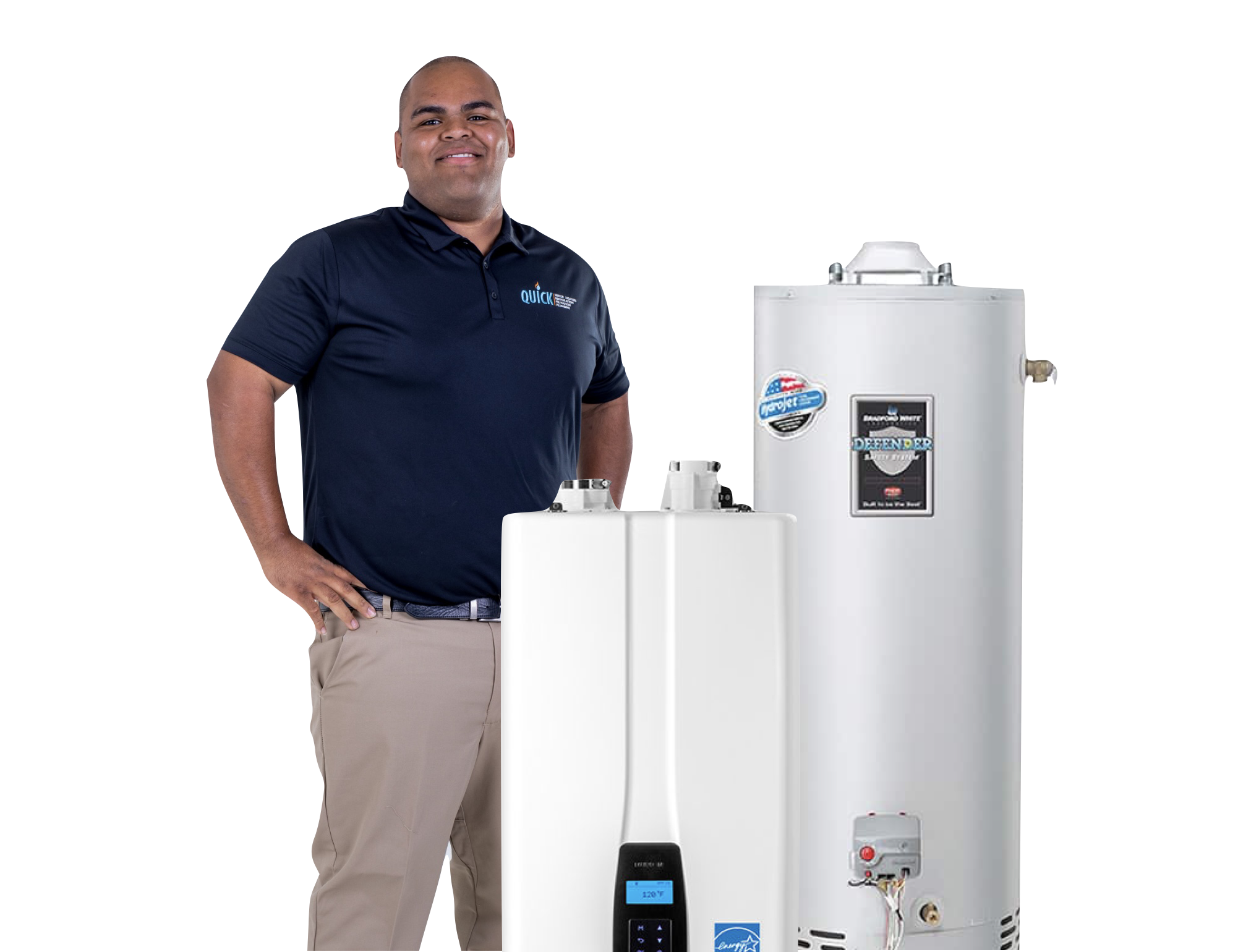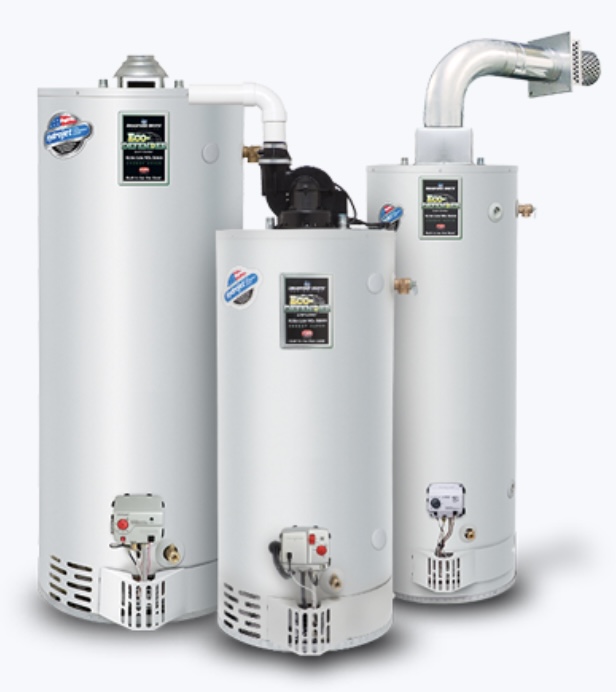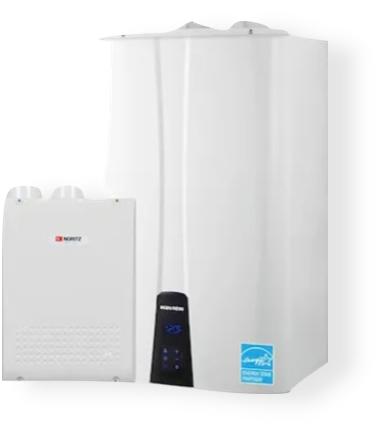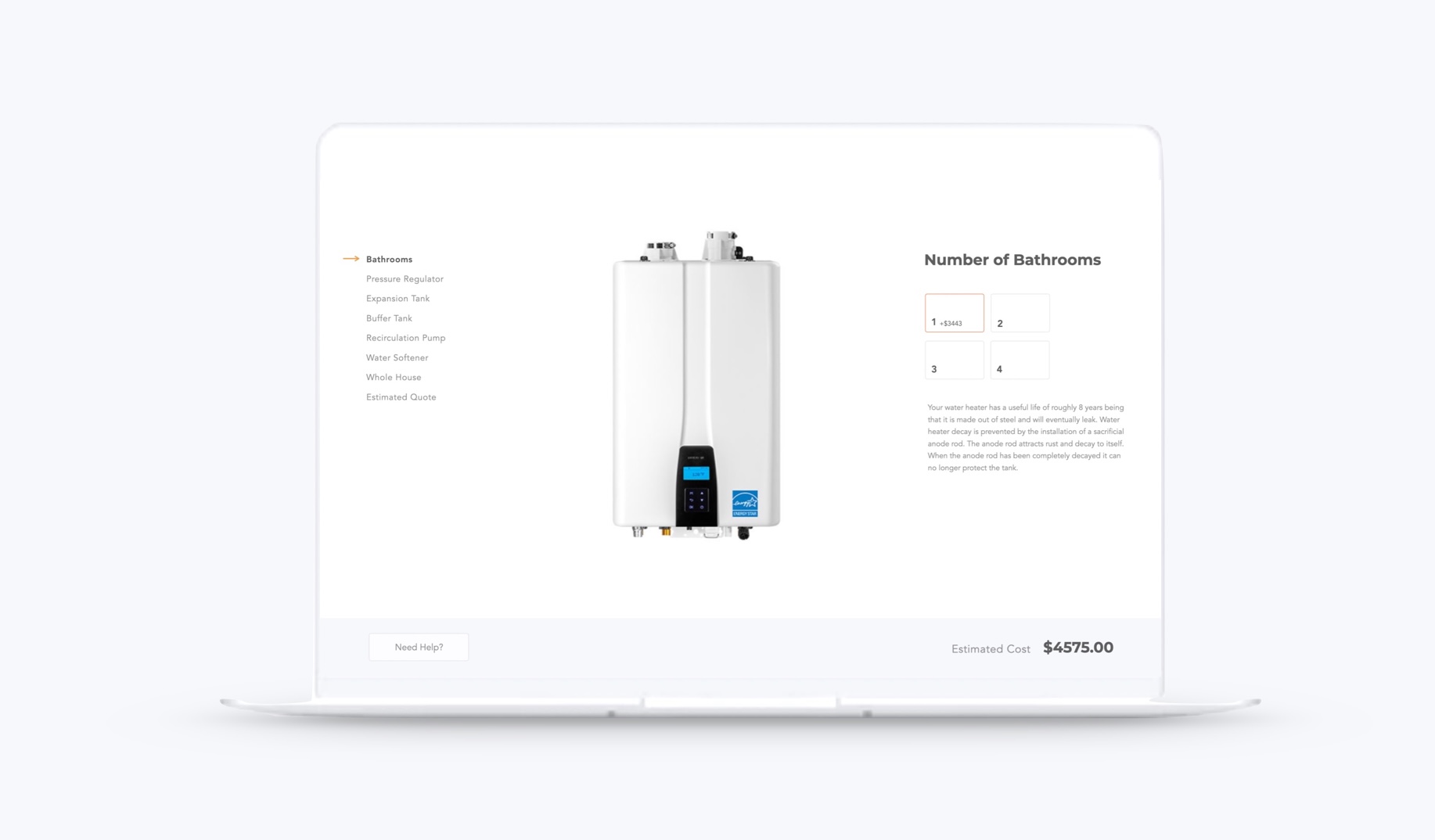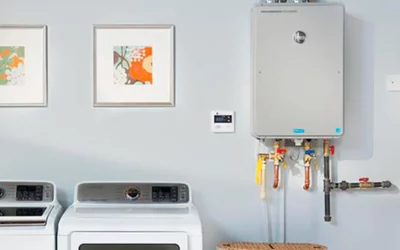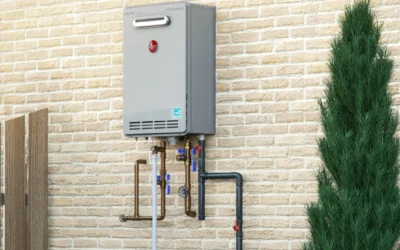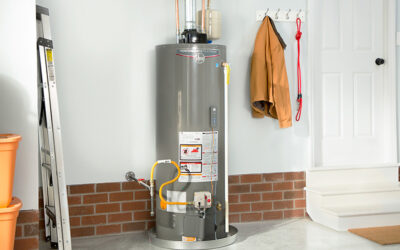Cost to Replace Gas Hot Water Heater
The cost to replace a 40 or 50-gallon basic water heater is $1580. Continue reading for details.
In this post, we will break down exactly how much it costs to have a reputable company install your hot water heater. Keep in mind, these are Southern California prices which are typically 10-40% higher than the national average. All prices below are for contractor-grade materials meaning, you can’t buy these at your local Home Depot. If you want to know the cost of a tankless water heater, click here.
- Water Heater – $697 (Rheem Professional Grade Water heater. Professional grade means only licensed professionals can buy, support and install these water heaters.)
- Water Shut Off Valve – $13
- Earth Quake Restraints – $35
- Drip Pan – $26
- Two Stainless Steel Supply Lines – $28
- Gas Sediment Trap – $20
- Gas Line with Shut off Valve – $46
- Exhaust Venting – $30
- Ten Feet of Copper (for drain line and incoming water lines) – $29
- Miscellaneous screws, shims bolts, map gas, solder, rags, flux, etc. – $42
Total Cost for Parts: $966
Business overhead is $425, which is equal to 20%-40% of the sales price. Why? The answer is that it is extremely expensive to operate a plumbing business. Examples of overhead expenses include (but are not limited to): Worker’s Compensation Insurance, Advertising & Marketing, Fuel, Uniforms, Maintenance, Office & Warehouse, General Liability. This is why most people do not understand why plumbers are so darn expensive. It’s costly to be a plumber in the state of California.
The cost for Labor is $250. In order to hire and maintain quality employees, they must earn a fair wage. A wage high enough to live in the areas they service and support their families.
The total profit is $250. After parts, costs, and overhead, the business must turn a profit otherwise it will go out of business. If the business you choose goes out of business, you will have no warranty and no support for the products that you invest in. Turnover within the plumbing industry is extremely high because of the cost of operation.
TOTAL COST $1895.00
• Gas Vs. Electric Storage Tank Water Heaters – Both gas and electric water heaters are nearly the same with the exception of the heating element. The gas unit has a burner underneath the storage tank whereas the electric unit has a heating element inside the storage tank. The gas unit has a chimney that runs up the middle of the storage tank. This chimney allows the used gases and heat to escape.
• The Storage Tank – Both electric and gas storage tank water heaters have a tank that holds the heated water until it is ready to use. The tanks are generally tested to hold at least 300psi. Most tanks have a glass liner to prevent the storage area from rusting.
• Keeping the Water Hot – Both storage tanks have insulation to help the hot water stay hot. In most cases, the insulation thickness will increase as the cost of the tank increases.
• Preventing Disaster – Both tanks have a drain valve that lets a user drain the water from a tank. They also have a pressure release valve to prevent the tank from exploding.
• Corrosion Prevention – Water heaters will naturally rust and decay from the inside out. To prevent decay, a sacrificial rod (anadode) is placed in the tank. This rod decays first and therefore prevents critical internal parts from corroding.
• Heating the Water – The Controller or thermostat maintains the water temperature inside the storage tank. Although water heaters can maintain a temperature of up to 180 degrees Fahrenheit the normal operating temperatures are between 120 – 140 degrees Fahrenheit.
• The Flow of Hot and Cold Water – Water heaters do not have a pump to move water in and out of the tank. They rely on the water pressure present in the house to allow the cold water to flow in and hot water to flow out. City water pressure is generally between 50 and 100psi. As a faucet is opened it allows the water to flow from the city line through your house and out of the faucet. As you create a demand for hot water, cold water flows from the city line and enters the tank. Because it is heavier (denser), it settles to the bottom. As the temperature in the tank falls due to the cold water entering, the thermostat turns the heating elements or the burner on. The hot water outlet is near the top where the hot water builds up. In summary, the cold water is on the bottom and the hot water is on the top.
How to Replace Your Anode Rod? Want Our Help? See Pricing Below
Anode Change – $225 (Includes parts and labor)
Water Heater Flush and Full Port Ball Valve – $175 (Includes Parts and Labor)
Package Deal – $325 for Both anode and Flush
Call Or Schedule an Appointment in the Upper Right Corner
In this video, we will show you exactly how to make your water heater last 20 to 50 years. By making your water heater last, you will save $3,000 – $10,000.
How To Fix Pilot Light That Won’t Stay Lit
QUICK ANSWER: A thermocouple lets the pilot light in your water heater stay on. When the thermocouple is operating properly it will tell the thermostat to turn on the main burner. The main burner is what heats the water in your water heater. The thermocouple is a very simple part but it has a very important job. If your thermocouple is not operating properly your water heater will not turn on.
TECHNICAL DETAILS: A thermocouple is a temperature-measuring unit that conducts energy between two dissimilar conductors. The unit is usually made of copper and a different metal. When one end of the thermocouple senses a different temperature it will create a small amount of electricity. I.e. one end in the pilot flame and one end in the thermostat. The millivolts are registered by the controller and allow the main burner to ignite. When the thermocouple is malfunctioning it will not keep the pilot light lit. When the pilot light is not lit, the thermostat will not allow the main burner to ignite.
How to Replace Your Temperature and Pressure Release Valve
QUICK ANSWER: The temperature and pressure release valve is a critical part of your water heater and your plumbing system. It prevents your water heater from exploding or causing a flood in your home.
DETAILS: The T&P valve is connected to your water heater but can be installed anywhere in your home’s plumbing system. It should always operate properly to ensure that your water heater doesn’t explode or cause a flood. The valve is designed to drain water if it senses the pressure is too high or the temperature is too high. The valve can easily malfunction and should be tested to make sure it is operating properly.
Unless you want massive problems, make sure it works as intended. Usually, they will open to protect the water heater and then will not close completely which causes a slow leak. In this video, I’ll show you how to replace the valve with a new one. I’ll show you a brief summary of how to solder copper. Also, consider what caused the valve to open in the first place. There could be a problem with your pressure regulator or possibly an overheating issue in the water heater. You must fix the cause or it will happen again.
How To Flush A Traditional Water Heater
QUICK ANSWER: Traditional storage tank water heaters should be serviced annually. Servicing should include a full flush plus a vacuuming of the interior of the tank. The water heater should be inspected for worn parts. The temperature and pressure valve should be changed every few years to ensure that it works properly in the event of a disaster. The most important step in servicing your water heater is inspecting and replacing anode rods. All the other steps combined are not half as important as replacing your anode rods.
DETAILS: When we do a water heater service we are looking for parts that can potentially fail or have already failed. The purpose of the service is to keep your tank in a healthy condition to extend the life of your water heater. If you service your water heater once every 3 years you can expect a long useful life. I wouldn’t be surprised to see a water heater last 20 years if serviced regularly. BENEFITS: Prevent flooding and water damage from a leaking tank.
Prevent replacement costs of your current tank.
Water Heater Anode Rods
Anode rod (leak Preventer) is a piece of metal that sacrifices itself to protect another piece of metal. Your water heater is made of steel. Steel is highly susceptible to rust and decay. In order to prevent the steel tank from rusting and eventually leaking, anode rods are installed. To be more specific, anodes pass their electrons to the steel to protect the steel. Think of wall spackle. You have a hole in your wall from a nail. You would spread the spackle in the hole and fill it. The anode acts just like a spackle. It takes its own electrons and gives them to the steel to make sure that it stays rust and decay-free. Like a can of spackle, your anode will not last forever. They can be changed every few years or installed with larger rods during installation. Theoretically, if you were able to change your anodes every 3 years your water heater would last 25-50 years. BUT, changing your anodes is nearly impossible once your water heater is installed. Ok, not impossible, but it’s very costly and better left to a trained technician.
Draining your Water Heater
Start at about 50 seconds on the video below. This video shows you how to flush your water heater but will also show you how to drain it too.
Draining your water heater can be very easy or quite a difficult process. In some cases you can connect a garden hose and drain your water heater. In other cases this will have to remove a fitting from the water heater and siphon the water out. Lets get started.
Step 1. Connect your garden hose to the drain valve at the bottom of the water heater.
Step 2. Open the drain valve on the water heater. Here water rushing out? Check the end of the garden hose to see if water is pouring out. If the water is dribbling out it could take hours to drain. If the water is dribbling out then we need to go to step 3. If the water is rushing out then your drain valve is not clogged. Shut the valve off on top of your water heater and open a few hot water faucets inside your house. You may have to shut the water off to the whole house if your water heater valve is broken. Your water heater should completely drain in about 30 minutes.
Step 3. Remove the TP valve. It’s the valve on the water heater that has a 1.5″ metal lift handle on it. See the picture of the TP valve displayed below. Note. In order to get the valve out of the water heater you will have to cut the copper pipe off. If you don’t see the copper pipe on your valve then proceed to unscrewing it.
Step 4. Once you have the valve out feed a garden hose into the hole and begin a siphon. This will drain a tank much faster than if you try and wait for a clogged drain valve. Once the tank is drained you can remove the drain valve and clean it out.
Installing a temporary water heater
You might need a temporary water heater if: your water heater flooded your house, your water heater is down for servicing, or many other reasons. We will explain how the process works. If you have a tank water heater we tap into the existing plumbing and run water lines to a 20-gallon electric water heater. If you have a tankless water heater we can tap into the service valve and run new water lines to a 20-gallon electric heater. Installing a temporary water heater is crucial when you have a water heater flood. In this case, all the drywall needs to be removed and replaced. During this process, we will install a temporary water heater. This allows the drywall to be replaced and the area to be completely dried properly. Here are some pictures of what this process looks like.
What is a Power Vent Water Heater
QUICK ANSWER: Power vent water heaters cost roughly $1,300 to $1,600 without installation. That is about 2-3 times what a normal atmospheric water heater costs. They are more efficient than an atmospheric water heater but usually require more maintenance in later years of operation. They were first introduced in the early 2000′s as a solution to vertical venting problems. If you have one it’s most likely in a condo built after the year 2000.
DETAILS: A power vent water heater has a fan on top of the water heater that forces the burned gases up the water heater’s vent. The fan has a secondary air intake to cool the gases down. The cooling of the gases allows PVC to be used as vent for the water heater. This water heater is commonly used in homes where a vertical vent can not be installed. Multi level condos usually have a power vent water heater in the garage. The main difference between a power vent water heater and an atmospheric water heater is the ability to vent the water heater in any direction. The vent is not limited to a vertical position. Power vent water heaters have a few similarities to tankless water heaters. Unlike standard atmospheric water heaters, power vent water heaters have an on board computer and an exhaust fan. This is what makes them less reliable than a standard water heater. If you have a power vent water heater you must replace it with a power vent water heater. In the long run, the energy efficiency will make up for the extra cost.
How To Drain and Flush Your Water Heater
Flushing your water heater offers the following benefits: increases the life span of your water heater, increases the efficiency of the water heater. Consider flushing your water heater like changing the oil in your car. If you don’t do it eventually you will need to replace your engine. Flushing the water heater ultimately prevents replacement costs and lowers your gas bill. Both save you money. In the video “how to flush your water heater (like a pro)” I’ll show you exactly how to flush your water heater the right way. In fact, i’ll even show you what happens when you do it the DIY way versus the professional way. At the end of the video I’ll show you a way to save thousands of dollars on your water heater expenses. Happy viewing.
If you prefer to read here is a step-by-step written version of the video.
Flushing Your Water Heater can be very easy or quite a difficult process. In some cases, you can connect a garden hose and drain your water heater. In other cases, this will have to remove a fitting from the water heater and siphon the water out. Let’s get started.
Step 1. Connect your garden hose to the drain valve at the bottom of the water heater.
Step 2. Open the drain valve on the water heater. Here is water rushing out? Check the end of the garden hose to see if water is pouring out. If the water is dribbling out it could take hours to drain. If the water is dribbling out then we need to go to step 3. If the water is rushing out then your drain valve is not clogged. Shut the valve off on top of your water heater and open a few hot water faucets inside your house. You may have to shut the water off to the whole house if your water heater valve is broken. Your water heater should completely drain in about 30 minutes.
Step 3. Remove the TP valve. It’s the valve on the water heater that has a 1.5″ metal lift handle on it. See the picture of the TP valve displayed below. Note. In order to get the valve out of the water heater you will have to cut the copper pipe off. If you don’t see the copper pipe on your valve then proceed to unscrewing it.
Step 4. Once you have the valve out feed a garden hose into the hole and begin a siphon. This will drain a tank much faster than if you try and wait for a clogged drain valve. Once the tank is drained you can remove the drain valve and clean it out.
Water Heater Temperature and Pressure Release Valve
QUICK ANSWER: The temperature and pressure release valve is a critical part of your water heater and your plumbing system. It prevents your water heater from exploding or causing a flood in your home.
DETAILS: The T&P valve is connected to your water heater but can be installed anywhere in your home’s plumbing system. It should always operate properly to ensure that your water heater doesn’t explode or cause a flood. The valve is designed to drain water if it senses the pressure is too high or the temperature is too high. The valve can easily malfunction and should be tested to make sure it is operating properly.
Water Heater Warranty Need Our Help? Follow These Links
Tank Water Heater Pricing
Tankless Water Heater Pricing
Get an Estimate to Process Your Warranty
Why is My Water Heater Leaking? Fix It With These 4 Easy Steps
https://www.youtube.com/watch?v=9oIqBJbPrX4&t=10s
In this short video, I am going to show you exactly why your water heater is leaking and how to fix it. I’ve broken this video into 4 sections.
- Section 1 will explain why your water heater is leaking.
- Section 2 will determine if it can repaired or will need to be replaced.
- Section 3 will explain how to stop the leak and get it fixed.
- Step 4 is a bonus that can save you $600-$1000. Your water heater might be under warranty. The manufactures sometime use codes to let us know what year your water heater was manufactured and if it is still covered under warranty. If it is you might be eligible for a FREE water heater. I’ll give you instructions on how to properly figure this out a the end of the video.
Section 1 Why is it leaking?
Water heaters leak for 2 common reasons. The first is lack of service and the second is high water pressure. If you don’t service your water heater the tank corrodes and eventually leaks. High water pressure from a broken pressure regulator can also cause a water heater to leak.
Section 2 Can your tank be repaired or does it need to be replaced?
- Step one Identify where the leak is coming from
- Top – usually a quick fix
- Cold in
- supply line, nipple or thread collar
- hot out
- supply line, nipple or thread collar
- vent connection
- usually will be spraying water and not dripping. This is how we see it in most cases.
- Cold in
- T&P Valve
- if the water is leaking from the joint where the valve threads into the tank the tank is not repairable
- If the water is leaking from the valve to where it terminates then you need to replace the valve.
- Usually about $35 dollars for parts. You will need a plumber or the ability to solder copper pipe. Best to have a plumber do it.
- If the valve is leaking then you most likely need a new water pressure regulator as well.
- Bottom
- If the water is collecting at the bottom of the water heater it has reached the end of it’s life. and needs to be replaced. If you live in San Diego County we would love to help you. Click the link below to see our advertised exact pricing for a replacement.
- Top – usually a quick fix
Section 3 how to stop the leak and begin repair or replacement
-
- Attach garden hose to drain valve
- open valve let water flow for 60 sections. it should flow freely. if you skip this step the water heater will not drain. If it doesn’t drain it will leak where it shouldn’t.
- Shut off water at shut off valve
- Open hot water fixture or undo a supply line
- show straw example
- drain water heater
- Turn off gas at shut off valve
- Time to call us or any qualified plumber. Before you do make sure you know the pro and cons of tankless water heaters. Link below.
- If your water heater still isn’t draining search our channel for a video on “Water Heater Will Not Drain”
Section 4
- Water heater manufactures don’t advertise the warranty terms on the water heater. They use codes to let plumbers know when the warranty is up. My guess is so that consumers don’t really know when the warranty is up, hence saving the manufacturer money. I have made a video to help you cut through the BS and figure out if you are eligible for a free water heater. Jump over to Quick water heater dot com. Click on FAQ and Search for “water heater warranty” in that video I’ll show you all the tricks we have learned over a decade of replacing water heaters.
How To Make Drain Valve? Need Our Help With Your Water Heater In San Diego? Follow These Links
Water Softener Pricing
Tank Water Heater Pricing
Tankless Water Heater Pricing
Repair Price List
Links for Parts:
2″ Brass Nipples
3/4″ Ball Valve
3/4″ cap
Pros and Cons of a Tankless Water Heater
Pros
• Save $175 to $275 per year by purchasing a tankless water heater. $2100 – $3300 over 12 years.
• They come with a 12 year warranty.
• Tankless water heaters can add value to your home and save you money each month.
• There are rebates through some utility companies.
• Endless hot water. This could be really beneficial for households that all shower at similar times.
• Quality tankless water heaters can last 10 years longer than a traditional storage tank water heater.
• They take up less space and can be used in an outdoor environment. This is good if you have a small house or need extra storage space.
• They are only using energy when you open a faucet.
•If you want to move your water heater to a different location, tankless water heaters are a great option.
• Most units have a remote control unit to help you control hot water usage and availability.
Cons
• Your natural gas line may need to be refitted to accommodate the additional gas demands of your tankless water heater. Gas line work is time consuming and expensive.
• Tankless water heaters need to be serviced yearly to prevent failure and maintain efficiency. Installing a water conditioner or de-scale filter on your tankless water heater will reduce annual service costs.
• Electric models may need an additional circuit – This option is not really a financially feasible option. They are unreliable and your house will need to be rewired to accommodate the massive amount of electricity they need. We do not install or service electric tankless water heaters.
• Tankless water heaters need to have electricity in addition to gas. We may need to subcontract an electrician to install a new electrical outlet near the tankless unit. This may increase the cost of installation.
Tankless Water Heaters 101
Unlike storage style water heaters, tankless water heaters create hot water only when you need it. Tankless water heaters never run out of hot water. Ok, maybe not never. A tankless water heater is only as good as the number of gallons it can produce per minute. I.e. if you have three showers running on a tankless system designed to provide hot water to one shower, you will experience luke warm water through your entire shower. In contrast, a storage style water heater may give all three showers hot water but the water may go cold half way through your shower. In each case a larger model may solve the problem, regardless of the type of water heater.
• Cost – San Diego is a great climate to use a tankless water heater. San Diego’s mild climate means that the water heater will not have to work as hard to bring the water to the desired temperature. Tankless Water Heaters are more complicated than there older, low tech counterparts. There are more parts and those parts are more complex. The price of a tankless water heater and installation can cost as much as 4-5 times that of a storage tank. Keep in mind that your existing water heater hook up will not provide enough gas supply to a tankless water heater. In addition, tankless water heaters require a new gas venting system. Furthermore, you may need to have a new gas meter and gas line run to the new heater to accommodate the increased gas requirements.
• Space Requirements – Tankless water heaters are generally much smaller than a traditional storage type water heater.
• Energy Efficiency – Tankless water heaters are only consuming electricity or gas when the demand for hot water is present. Unlike tankless water heaters, storage tank water heaters are maintaining hot water on a constant basis. In summary, tankless water heaters save you money by only using resources when they are in demand.
• Point of Use and Whole House – Ever sat in the shower waiting for the water to get hot? We all have. Point of use water heaters are designed to reduce the time and water wasted waiting for the water to travel from your water heater to the sink or shower. Point of use water heaters are usually less than five gallons and are normally installed within a few feet of the point of use. They allow hot water to reach the point of use much quicker than any other style of water heater. This water heater is only used to supplement your hot water on one point of use. I.e. the bathroom or kitchen. POU water heaters are generally electric and maybe tankless or storage style systems.
• What Size Tankless Water Heater Do I need? – There are two factors to consider. The flow rate and the temperature rise.
o Flow rate is the maximum amount of hot water you and your household need to maintain constant hot water.
o The temperature rise is the difference between what the city water temperature and the desired output temperature.
o A simple calculation will help you determine how many gallons per minute your tankless water heater needs to produce to meet your hot water needs.
– Bathroom Faucet – 3GPM
– Kitchen Faucet – 4GPM
– Shower – 4 GPM
– Appliance – 4 GPM
Add these figures to determine what your flow rate is. I.e. If an appliance, a shower, and a faucets are running simultaneously you will need to choose a water heater that can produce at least 11GPM. But hang on. We also need to consider how hard the water heater has to work to reach your desired output temperature. Assuming average conditions, a water heater will not have to work as hard in Hawaii as it will in Alaska. Southern California usually has average ground water temperatures equal to our average air temperature. I.e. If you want your shower to be 110 degrees and your average ground water temp is 70 degrees the temperature rise will be 40 degrees. In this example, you will be looking for a water heater with a flow rate of 11 gallons per minute and a temperature rise of 40 degrees.
Servicing a Tankless Water Heater
QUICK ANSWER: Tankless water heaters must be serviced. Servicing should be frequent and constant. A servicing really means flushing the heat exchanger with vinegar. I promise you will be replacing your tankless sooner than you expect if you do not service the heater.
DETAILS: Tankless water heaters have a radiator inside that needs to be flushed out. Service valves or isolation valves are critical in properly servicing a tankless water heater. Flushing the radiator with vinegar helps remove mineral deposits inside the heat coils. When the water passes through the radiator or heat exchanger, it leaves behind expelled minerals. If not removed from the radiator the minerals will clog the heat coils and cause your radiator to leak. When the radiator leaks it will damage the computer, the fan and other electrical components. If you do not service your water heater you will experience heat loss and eventually you will need to replace the heat exchanger or the whole tankless water heater.
BENEFITS: Flushing your tankless water heater will maintain the efficiency of the heater as well as it’s life span. You paid a lot of money for your tankless water heater. Make sure you don’t have to replace it prematurely.
Alternative Tankless Maintenance
Summary: This is an idea that 100% of Tankless water heater companies would advise you not to do. However, it can be just as effective if not more effective than normal maintenance. Here it is. Never service your tankless water heater. Ever. Tankless water heaters in the southern regions of the united states suffer from scale build up in the heat exchanger. Manufactures advise flushing the water heater with vinegar or some other gentle acid. The acid in vinegar or CLR break up the calcium and magnesium scale. Ultimately the flush cleans the inside of the copper heater exchanger to make sure that the water heater functions properly.
BEWARE: This method will fix the build up in the heat exchanger but will not help build up in all the other water ways in the unit. Sensors, and all other water ways will still suffer hard water build up. So although it solves most of the problem of maintenance it still doesn’t protect the entire system.
Here are the details: tankless water heater servicing costs between $100-$225 per year. Servicing your tankless water heater adds up quickly plus it can be time consuming to have a technician come to your house every year to service your water heater. Alternatively, changing the heat exchanger only needs to be done every 5 years as opposed to every year. The replacement service costs $600-$800 dollars.
Alternative to the Alternative: Don’t risk it! Get a proper water treatment system installed on the unit or your entire house. This way you don’t have to service the system and you get the benefits of treated water. See more in water filtration section.
Hot Water Recirculation Pumps 101
QUICK ANSWER: Recirculation pumps are the greatest! Honestly! Who wants to wait a few minutes every time you want hot water? You may not realize it but the pipe that runs from your water heater to your faucet or shower may be hundreds of feet long. It can take minutes to finally get to your shower. I am sure you know exactly what I am talking about. In short, the pump makes sure that when you open a faucet, hot water is instantly available.
BENEFITS: Get hot water when you want it without waiting. Save a ton of water! It’s estimated that your family will waste 4000 gallons of water a year waiting for hot water. That’s a lot of money down the drain. The pump will pay for itself over the years you own it. Since it pays for itself, why not have one installed and not ever wait for hot water. I couldn’t live without mine.
STORAGE TANK RECIRCULATION PUMPS: There are several ways to recirculate hot water with a storage tank water heater. The first way is to run an additional pipe to your furthest fixture in your plumbing system and run it back into your water heater. This process is the most difficult and requires the most labor. If you do not already have a “runback pipe” the cost to install a new one can be crazy expensive. Think $1000 or more. The next three options do not require a run back pipe. The Pump under the sink option. The pump can be set up with a motion sensor or a button. These two options are decent but it still requires effort. You have to remember to hit the button or walk in front of the sensor. In my opionion they are both inferior options. The best option in my opinion is the Comfort Series by Grundfos. It attaches to your heater and uses a thermovalve that keeps the hot water hot without any effort on your part. Call me lazy but I’d rather not have to work to get hot water.
TANKLESS RECIRCULATION PUMPS: Your tankless water heater gives you unlimited hot water. It does not give you instant hot water. To get both instant and unlimited hot water you need a recirculating pump. So, here is where it gets interesting. Recirculation pumps really are not designed to be used on a tankless water heater. A tankless water heater can definitely operate with a recirculation pump BUT it comes at a huge cost. If you put a recirculating pump on a tankless water heater it will cut the warranty down to a few years or void it all together. Tankless, or on demand water heaters are designed to turn on when you need hot water and turn off when you don’t. With a recirculating pump, your tankless water heater is now forced to stay on all the time. Keeping your tankless water heater on all the time drastically shortens the life of the heater. In my experience, you will cut the life of your water heater in half. That’s in optimal conditions. In the field, I’ve seen heaters go out in 2 years that should have at least made it 10 years. Needless to say, customers were not happy with this situation. My answer is a small buffer tank with special valves that allows the tankless heater to retain its 12 year warranty plus give you instant hot water. Boom! Back in business. This is a really cool system that solves all the problems associated with recirculation pumps and tankless heaters.
Water Heater Expansion Tanks
QUICK ANSWER: Water heater expansion tanks are designed to absorb high pressure. They are recommended if you would like to get full life out of your water heater and plumbing system.
DETAILS: Your first line of defense against a pressure surge is your pressure regulator. Your second line of defense against high pressure is your thermal expansion tank. When water is heated it will expand. The expanding water creates high pressure in your plumbing system. High pressure is very bad for your water heater and plumbing system in general. It can cause your appliances and pipes to fail prematurely. Premature failure almost always results in water where you don’t want it to be. Keep in mind. If your pressure regulator is not working properly your expansion tank will not work properly. It is best to change them together to ensure that one doesn’t cancel the other out.
BENEFITS: Extends the life of all your appliances and plumbing fixtures in your home. An expansion tank will usually curb water hammer and banging pipes. When used in conjunction with a pressure regulator it will prevent leaky faucets, toilets that fill without flushing, broken icemakers, damaged dishwasher and malfunctioning RO systems.
What is a Pressure Regulator
QUICK ANSWER: Tankless water heaters must be serviced. Servicing should be frequent and constant. A servicing really means flushing the heat exchanger with vinegar. I promise you will be replacing your tankless sooner than you expect if you do not service the heater.
DETAILS: Tankless water heaters have a radiator inside that needs to be flushed out. Service valves or isolation valves are critical in properly servicing a tankless water heater. Flushing the radiator with vinegar helps remove mineral deposits inside the heat coils. When the water passes through the radiator or heat exchanger, it leaves behind expelled minerals. If not removed from the radiator the minerals will clog the heat coils and cause your radiator to leak. When the radiator leaks it will damage the computer, the fan and other electrical components. If you do not service your water heater you will experience heat loss and eventually you will need to replace the heat exchanger or the whole tankless water heater.
BENEFITS: Flushing your tankless water heater will maintain the efficiency of the heater as well as its life span. You paid a lot of money for your tankless water heater. Make sure you don’t have to replace it prematurely.
Water Heater Permit Summary
QUICK ANSWER: Almost every time you have your water heater replaced, a permit is required by law. The permit helps protect home owners from improper installation and sloppy work. Most plumbers will avoid talking about a permit. Permits require plumbers to complete work to code. Code requirements can increase the cost to the customer and to the plumber. Basically, a plumber can install a water heater without considering code requirements for a lot less than if he adheres to the plumbing code. Quick
Water Heater does every job to code, every time.
DETAILS: The homeowner or the contractor who does the work can apply for a permit. The permits are sometimes available online. If the permit is not available online you will have to go to your city building office and apply in person. The process can be very simple or sometimes very complicated. It really depends on the city you live in. We have seen permits cost as much as $220 and as little as $117. Each city charges a different amount. After the application has been submitted to the city you will need to call the inspection office to schedule a time for the inspector to look at the completed project.
When the inspector has approved the work the permit process is complete. If there is a problem with the installation the contractor must correct the problem and schedule a second inspection. Sometimes the inspector will leave an inspection sheet and sometimes the inspector will not leave an inspection sheet. In either case, the permit is filed with the city and stored with all your other building permits. If you decided not to pull a permit there can be fines and penalties. The penalty for some cities is as low as $50.00. The penalty could be higher in other cities.
SUMMARY: The permit is the final stamp of approval from your city. Without it, you may not ever know if the job was done to code. It is always a good idea to get a permit.
Services We Provide
We specialize in water heaters and water filtration systems. We will do any other plumbing work with the exception of drains.
Water heater repair, water heater replacement, fix all parts related to water heater operation. See below for a detailed list of services.
Service we do not provide: Quick Water Heater Company does not do drain clearing or repair. We will however do all other plumbing work.
Shut off Valves – Shut off valves are an extremely important part of your homes plumbing system. Quick Water Heater Company can replace and repair all shut off valves, including gate valves (garden hose valve)
and ball valves. We always check to make sure that all your shut off valves are working properly. We will generally encourage our customers to change a damaged main shut off valve. We also change the shut off valve to the water heater. With out a functioning shut off valve you cannot shut your water off to your home nor can you isolate a leaking appliance. Changing your shut off valves ensures that if you have a problem in the future, you can easily prevent flood damage.
Pressure Regulators – Pressure regulators are an extremely important part of your homes plumbing system. A pressure regulator is placed in-between your home and the city water coming from the curb. A pressure regulator controls the water pressure that can enter your house. For example, the city water pressure can reach 120 pounds per square inch. The pipes and appliances in your home require 60 pounds per square inch (PSI). If your home did not have a regulator constantly absorbing the city water spikes, your
appliances will be damaged. For example, a water heater that has 110 PSI entering the tank will have less than half of it’s normal operating life. This is because the water is pushing on all the valves and entry points
that are designed to operate at 60 PSI. Basically it’s like blowing a balloon up until it pops. High pressure can also lead to pipe bursts in the walls and slab. Quick Water Heater Company will always test your pressure regulator and make sure that it works properly.
Water Heater Stands – Water heater stands are used when a water heater is located in the garage. According to the uniform plumbing code, a water heater installed in a garage must be installed 18 inches above the garage floor. This code is in place to ensure that if combustible gases collect near the garage floor, the pilot light from the water heater will not ignite the gasses. Quick Water Heater will always inspect your stand and make sure that it is structurally sound. Quick Water Heater Company can replace the water heater stand
if necessary.
Earth Quake Straps AKA Seismic Straps – Earth quake straps are designed to hold your water heater in place if an earthquake happens. If your water heater were to fall over in an earthquake it could cause the cold water input line to break and flood your home. In addition, the gas line could break and leak gas into your home. This could cause an explosion. As you can see, keeping your water heater firmly planted in place is critical if an earthquake happens. We will inspect your earth quake straps to make sure they are up
to code and mounted firmly in a wall beam.
Water Heater Supply Lines – Water heater supply lines are usually made of flexible copper tubing. These supply lines allow a water heater to be quickly removed from the plumbing system. Without proper supply lines, water heaters can only be removed by a plumber. Quick Water Heater Company will almost always change your supply lines. Changing the supply lines ensures that your water heater will have the longest life possible.
Gas Water Heater Venting – Gas water heaters have an exhaust vent that allows burned gasses and hot air to escape through the roof of your home. When replacing a water heater, the venting system may need to be replaced or modified to accommodate your new water heater. We will always inspect your venting system and repair or replace any existing problems. Gas venting is almost always replaced when installing a tankless water heater.
Temperature and Pressure Release Valve AKA T&P Valve – The T&P valve is by far the most important feature of your water heater. The T&P valve has two very important functions. One is to prevent your water heater from over heating. The second is to prevent pressure build up. If your water heater reaches 210 degrees, the valve will open up and release hot water. If the internal pressure in the water heater reaches more than 150 psi, the valve will open and release the excess pressure.
Gas supply line – Gas lines are usually flexible hoses that connect your homes gas system to your water heater. Gas lines can become damaged over time and may need to be replaced. Quick Water Heater Company will inspect and replace any damaged gas supply lines.
Gas Shut Off Valves – Gas shut off valves are mounted on your homes gas supply system. These valves are very important and should be in 100% working condition. Quick Water Heater Company will inspect and replace any valve that is not in 100% working condition.
Who Is Quick Water Heater
My name is Brandon Baril, I am the founder of Quick Water Heater. I built Quick Water Heater on an old-school business foundation. A foundation where your word means more than anything and consistently doing right eventually comes back around. As a business, we focus on the best of the best and back it up with a no-questions-asked guarantee. We don’t try to do a million things. We do one thing – water heaters. I believe we’re the best in our trade.
Check out our Instagram account to see pictures of the crew. instagram.com/quickwaterheater
Check out our Facebook page to see pictures of the crew. facebook.com/QuickWaterHeater


